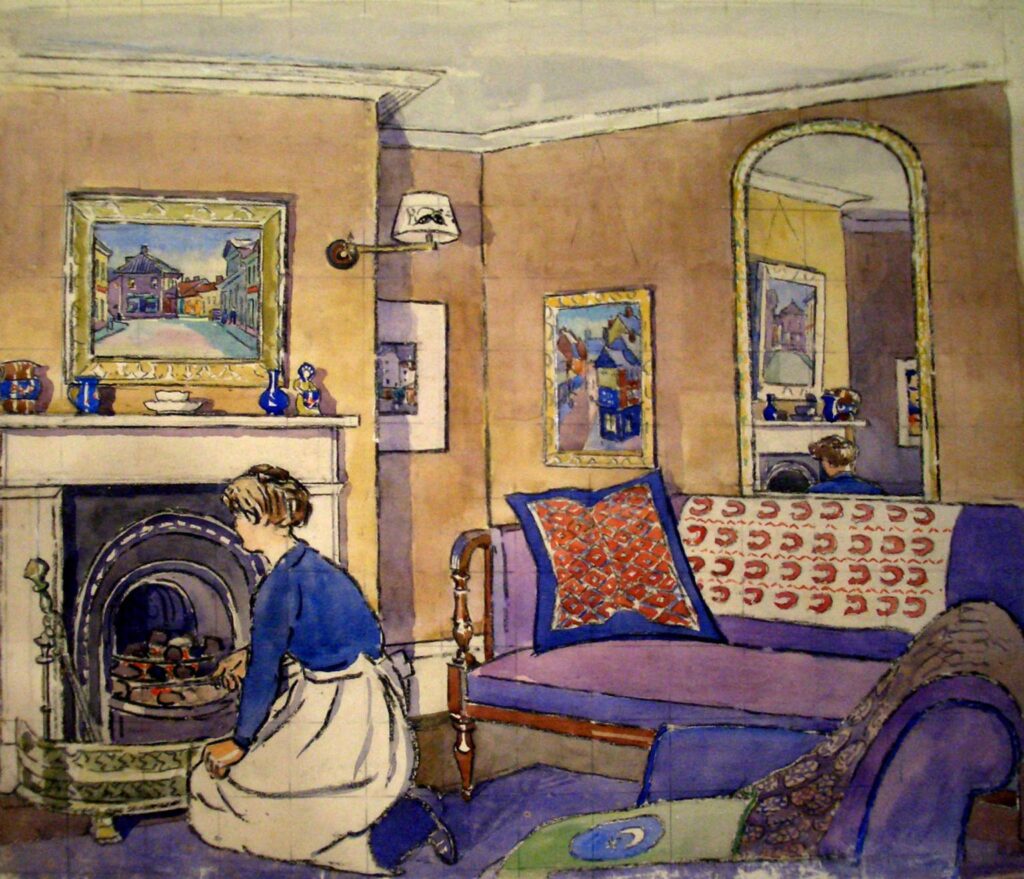Interiors by Design: Drawing Rooms

Names used for the rooms in middle- and upper-class homes have changed over the years, and are horribly inconsistent. Bedroom, kitchen and dining rooms are relatively straightforward, but when you come to those collectively termed reception rooms it’s hard to know which is a living, sitting or drawing room, or parlour for that matter.
For those with more than one reception room, there’s some consensus that the drawing room is the smartest in the house. Its name originates not from art, but is an abbreviation for withdrawing room, as one of its widespread purposes was for the ladies to withdraw to after dinner, leaving the men drinking brandy or port and smoking cigars in the dining room before rejoining the ladies.
Augustus Leopold Egg (1816–1863), Past and Present, No. 1 (1858), oil on canvas, 63.5 x 76.2 cm, The Tate Gallery, London. Photographic Rights © Tate 2016, CC-BY-NC-ND 3.0 (Unported), http://www.tate.org.uk/art/artworks/egg-past-and-present-no-1-n03278
The first of Augustus Egg’s narrative series Past and Present from 1858 shows an ordinary middle-class drawing room, in which there are mother, father, and two young daughters, each well-dressed. Most striking is the mother, who is stretched out across the green carpet, prone. Her arms are stretched beyond her head, which is buried face down between her upper arms, and the hands are clasped together in tension.
Father is sat at a substantial circular table, facing the viewer. He is staring, brow furrowed, looking extremely tense and worried. His left hand holds a small note; his right hand is clenched, and rests on the table. His left shoe presses a miniature painting into the carpet.
The daughters are playing together at the left, opposite their father. One kneeling, the other sat, on the carpet, they’re building a house of cards that is just about to fall. One stares, her mouth slightly open in anxious surprise, looking towards where her mother might have been standing before she fell to the floor. The other girl is still looking intently at the house of cards.
The room is full of cues, clues, and symbols to its narrative. Among the more visible are: the collapsing house of cards; an apple has been cut in two, one half left on the table, the other on the carpet by the mother; the reflection of an open door indicating the imminent departure of the mother. Egg also uses Hogarth’s technique of paintings within the painting. On the wall at the left is the expulsion of Adam and Eve titled The Fall, below which is a miniature portrait of the mother; at the right is a shipwreck by Clarkson Stanfield titled Abandoned, and below a portrait of the father.
Harriet Backer (1845–1932), Chez Moi (1887), oil on canvas, 88.5 x 100 cm, Nasjonalgalleriet, Oslo. Wikimedia Commons.
When Harriet Backer was back in Paris, she continued to explore the play of light in interiors, with Chez Moi from 1887 as an example. The piano keys, dress, plant, window blind and reflections on the pictures hanging on the wall are each shown with precision. An open violin case on the chair suggests the pianist is accompanying another musician.
Anna Alma-Tadema (1867–1943), Sir Lawrence Alma-Tadema’s Library in Townshend House, London (1884), watercolor and gouache, pen and ink, graphite on white paper, dimensions not known, Cooper Hewitt, Smithsonian Design Museum, New York, NY. Wikimedia Commons.
Anna Alma-Tadema was a precocious and brilliant painter in watercolours, and her earliest surviving works, made when she was only seventeen or eighteen, document the interior of the family home near Regent’s Park, London. Sir Lawrence Alma-Tadema’s Library in Townshend House, London (1884) is a meticulously-detailed account of that room, even down to its stained glass. The strange brass case on the floor in front of the couch is a coal scuttle for the fire to the left.
Anna Alma-Tadema (1867–1943), The Drawing Room, Townshend House (1885), watercolor, pen and Indian ink over pencil on cardboard, 27.2 × 18.7 cm, Royal Academy of Arts, London. Wikimedia Commons.
Her small watercolour of The Drawing Room, Townshend House (1885), painted the following year, shows her improved skills at depicting surface light and texture. Suspended above its ornate decor is an elaborate bird cage.
Félix Vallotton (1865–1925), The Red Room (La Chambre rouge) (1898), distemper on cardboard, 50 x 68.5 cm, Cantonal Museum of Fine Arts, Lausanne, Switzerland. Wikimedia Commons.
Although Félix Vallotton was still under Nabi influence when he painted The Red Room in 1898 using distemper, his motif is novel in being one of his early domestic interiors. A man and woman stand in a loose embrace in the doorway of a living or drawing room with brick red decor. Above the fireplace is what could be a mirror, or a painting, in which a person dressed in black is standing in the distance, apparently looking away from the couple.
Harold Gilman (1876–1919), Edwardian Interior (c 1907), oil on canvas, 53.3 x 54 cm, The Tate Gallery (Presented by the Trustees of the Chantrey Bequest 1956), London. © The Tate Gallery and Photographic Rights © Tate (2016), CC-BY-NC-ND 3.0 (Unported), https://www.tate.org.uk/art/artworks/gilman-edwardian-interior-t00096
Harold Gilman, a member of the Camden Town Group, painted domestic interiors, including this early Edwardian Interior from about 1907. This shows the drawing room of his family home in the Rectory at Snargate, with the artist’s youngest sister as model. The surface of a chest of drawers is covered with ceramic vases, bowls, and a painted buddha.
Douglas Fox Pitt (1864–1922), Interior with Maid (c 1913), graphite, charcoal and watercolour on paper, 41.2 x 48.3 cm, The Tate Gallery (Presented by Sarah Fox-Pitt and Anthony Pitt-Rivers 2008, accessioned 2009), London. © The Tate Gallery and Photographic Rights © Tate (2016), CC-BY-NC-ND 3.0 (Unported), https://www.tate.org.uk/art/artworks/fox-pitt-interior-with-maid-t12996
Another member of the group, Fox Pitt painted this Interior with Maid in about 1913, where his choice of paintings is of particular significance. Above the fireplace is Harold Gilman’s Norwegian Street Scene (Kirkegaten, Flekkerfjord) (1913), and above the bright cushion is Charles Ginner’s The Wet Street, Dieppe (1911). It’s thought that the sofa throw came from the Omega Workshops, established by Roger Fry, Duncan Grant and Vanessa Bell. Together these make it a truly avant garde interior of the time.



